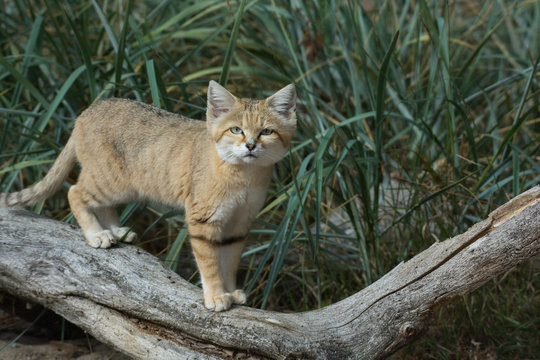ANIMAL: Sand Cat Felis margarita Type of Animal: Feline Habitat: Deserts w/ little to no vegetation, sandy desert, stony desert, rocky desert, sandy dry plains, rocky valleys, dunes, gritty sandy areas, arid stony plains, desert plains w/ little vegetation, arid shrub-covered steppe Location(s): N Africa, Middle & Near East, C Asia Appearance: Small pale sandy to gray-brown cat, darker on back & paler on belly, broad head, low-set ears, sometimes has striping on legs. Arabian subspecies larger than Saharan subspecies. Saharans brighter & yellower while Arabians darker & grayer. Food/Diet: Rodents, hares, rabbits, birds, reptiles (including venomous snakes), spiders, insects Status in Wild: Stable Conservation: Breeding in zoos & wildlife centers. Reintroductions into parts of range. Lifestyle: Solitary Additional Info: Called: Male: Tom Female: Queen Young: Kitten Group: Solitary Weight: Male: 4.63-7.49 lbs Female: 3.09-6.83 lbs Young: 2 lbs Gestation: 2 months Life Span: 7-8 years in wild, 12-13 years in captivity Height: Male: 1 ft Female: 0.83 ft Body Length: Male: 1.5-1.875 ft Female: 1.25-1.6 ft Tail Length: 0.92-1.16 ft, same for both sexes Main predators of adults are canids, raptors, & caracals. Snakes & feral cats prey on kittens. These cats mainly nocturnal or crepuscular. These cats can reach sexual maturity as early as 3.5-4 months old. They utilize burrows to shelter from extreme heat as well as extreme cold. Thick fur on paws comes in handy for climate they come from. These cats use mews & high-pitched raspy barks as mating calls. These cats are quite shy in the wild. While stable, these cats do face threats like hunting for sport, habitat loss/degradation, pet trade, persecution as chicken thieves, poisoning, competition w/ domestic/feral dogs & cats, predation by domestic/feral dogs & cats, disease transmission from cats & dogs, livestock grazing, & strife. Litters range from 1-8 kittens. Ears help aid in thermoregulation. Fun Fact(s): Toubou people northwest of Lake Chad don’t hunt these cats because of belief that they were companion of Prophet Muhammad & his daughter. While cute, these cats do not make good pets. These cats can be fierce when cornered. Margarita part of scientific name named after French general Jean Auguste Margueritte, who “discovered” species in 1858. These cats can survive w/o drinking water for weeks at a time. These cats obtain most moisture from prey.
